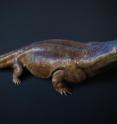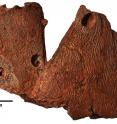Prehistoric super salamander was top predator, fossils suggest
Related images
(click to enlarge)
A previously undiscovered species of crocodile-like amphibian that lived during the rise of dinosaurs was among Earth's top predators more than 200 million years ago, a study shows. Palaeontologists identified the prehistoric species -- which looked like giant salamanders -- after excavating bones buried on the site of an ancient lake in southern Portugal.
The species was part of a wider group of primitive amphibians that were widespread at low latitudes 220-230 million years ago, the team says.
The creatures grew up to 2m in length and lived in lakes and rivers during the Late Triassic Period, living much like crocodiles do today and feeding mainly on fish, researchers say.
The species -- Metoposaurus algarvensis -- lived at the same time as the first dinosaurs began their dominance, which lasted for over 150 million years, the team says. These primitive amphibians formed part of the ancestral stock from which modern amphibians -- such as frogs and newts -- evolved, researchers say.
The species were distant relatives of the salamanders of today, the team says. The discovery reveals that this group of amphibians was more geographically diverse than previously thought.
The species is the first member of the group to be discovered in the Iberian Peninsula, the team says.
Fossil remains of species belonging to the group have been found in parts of modern day Africa, Europe, India and North America. Differences in the skull and jaw structure of the fossils found in Portugal revealed they belong to a separate species.
The new species was discovered in a large bed of bones where up to several hundred of the creatures may have died when the lake they inhabited dried up, researchers say. Only a fraction of the site -- around 4 square meters -- has been excavated so far, and the team is continuing work there in the hope of unearthing new fossils.
Most members the group of giant salamander-like amphibians was wiped out during a mass extinction 201 million years ago, long before the death of the dinosaurs. This marked the end of the Triassic Period, when the supercontinent of Pangea -- which included all the world's present-day continents -- began to break apart. The extinction wiped out many groups of vertebrates, such as big amphibians, paving the way for dinosaurs to become dominant.
The study, published in the Journal of Vertebrate Paleontology, was funded by the German Research Foundation and the National Science Foundation, the Jurassic Foundation, CNRS, Columbia University Climate Center and the Chevron Student Initiative Fund. Additional support was provided by the Municipality of Loulé, Camara Municipal de Silves and Junta de Freguesia de Salir in Portugal.
Dr Steve Brusatte, of the University of Edinburgh's School of GeoSciences, who led the study, said: "This new amphibian looks like something out of a bad monster movie. It was as long as a small car and had hundreds of sharp teeth in its big flat head, which kind of looks like a toilet seat when the jaws snap shut. It was the type of fierce predator that the very first dinosaurs had to put up with if they strayed too close to the water, long before the glory days of T. rex and Brachiosaurus."
Dr Richard Butler, of the School of Geography, Earth and Environmental Sciences at the University of Birmingham, said: "Most modern amphibians are pretty tiny and harmless. But back in the Triassic these giant predators would have made lakes and rivers pretty scary places to be."
Dr Steve Brusatte will discuss his work on recently discovered species and other aspects of palaeontology at a series of events at the Edinburgh International Science Festival, which runs from 4-19 April.
Source: University of Edinburgh
Other sources
- Car-sized super-salamander may have dined on dinosaursfrom CBC: Technology & ScienceTue, 24 Mar 2015, 21:00:22 UTC
- Prehistoric super salamander was top predator, fossils suggestfrom Science DailyTue, 24 Mar 2015, 14:30:31 UTC
- Killer salamanders dominated ancient Portugalfrom UPITue, 24 Mar 2015, 14:00:16 UTC
- Researchers find fossil of 'Super Salamander' speciesfrom AP ScienceTue, 24 Mar 2015, 10:40:04 UTC
- Prehistoric super salamander was top predator, fossils suggestfrom PhysorgTue, 24 Mar 2015, 0:00:12 UTC

